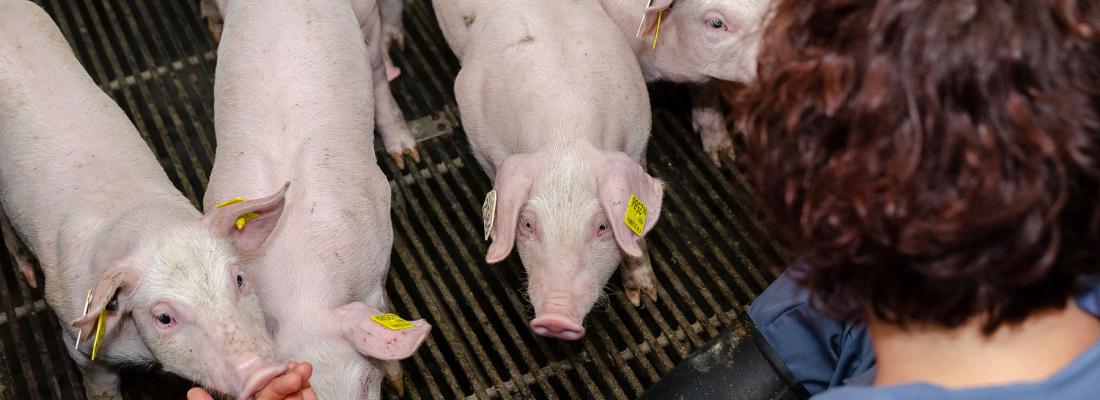Agroecology Reading time 3 min
Animal welfare: humans, objects or conspecifics, piglets tell us what they prefer
Published on 27 November 2020

Like most mammals, pigs vocally express a lot of emotions such as joy, fear, frustration. To do this, they emit a whole battery of more or less high-pitched and more or less long vocalizations: barking, squeaking, screaming and grunting are all types of vocalizations that can be associated with positive or negative contexts. Grunts are the most used and yet the least understood. By deciphering them, scientists seek to translate the emotional state of pigs in order to better understand their perception of their environment and to adapt farming conditions so as to promote their welfare. In this study, ethologists aimed to accurately describe the grunts of piglets in different situations, and to measure the level of welfare provided by the relationship with humans.
A human or a friend: no contest!
In the first study, the scientists sought to find out whether a piglet preferred a familiar human with whom it had established a positive relationship (stroking, playing...) or a familiar conspecific living in the same pen. The work involved 60 piglets aged 28 days at the start of the study and 62 days by the end of it. The researchers taught them to anticipate the arrival of the familiar human or piglet using an audible and visual signal specific to one or the other that was triggered 20 seconds before the partner entered. During the test, they recorded and analysed the piglet's grunts at the time of the signal, whether it announced the arrival of the human or a familiar conspecific. The test was performed 12 times for each partner and each piglet. During the final test, the arrival of the expected partner was delayed by 1min30, which was not what the piglet expected and caused stress and frustration. The results show that piglets anticipate the arrival of a human or a conspecific in a different way. They utter short, high-pitched grunts and are more excited by the signal of the arrival of their conspecific, while the anticipation of the human's arrival translates into longer grunts. In the situation where the arrival of the conspecific was delayed, the grunts became longer, like those emitted when expecting the human, indicating some frustration. These results show that not only can piglets anticipate a situation, but that they also categorize and prioritize their expectations: the announcement of the arrival of the human rather than the conspecific signifies a certain frustration, showing that the piglets prefer their conspecifics to a familiar human. They also show that vocalizations, on their own, make it possible to precisely characterize the perception of different situations by piglets, and therefore to assess their state of welfare.
A familiar human: a reassuring effect
European legislation1 states that the environment of domestic pigs must be improved by providing manipulable and chewable objects, such as ropes or tubes, as they can induce positive emotional states by allowing them to reproduce natural behaviour. Likewise, positive and repeated contact with a familiar human, such as stroking, can also be enriching because it brings new interactions and generates positive emotional states. In this second study, the scientists compared how piglets perceived a familiar object or a familiar human by analysing their behaviour and the grunts they made.
This study involved 24 piglets aged 28 days at the start of the study and 57 days by the end of it. An initial period of habituation allowed the piglets to become familiar with the object and the human individually. For the first test, each piglet had to choose between the human and the familiar object. While the piglets did not show a preference between the human and the object, they would lie down closer to the humans and seemed to be reassured. In the second test, the piglets were isolated for 5 minutes, which is a source of stress for them, and then reunited either with the object, or with the human, or remained isolated. In this test, the analysis shows that piglets emit different grunts in different situations. Only when reunited with the human did the piglets utter short, high-pitched grunts characteristic of positive emotions, were less alert, and approached the human more quickly than the object. The familiar human may therefore be a more effective source of reassurance and welfare for the piglet than objects.
The grunts of piglets provide a lot of information regarding their emotional state. By collecting data in a non-invasive way, which involves installing microphones in pigsties, understanding these sounds gives breeders the keys to creating situations that promote pig welfare. This work also shows the importance of positive interactions with humans which, while they may not be worth the interactions with their conspecifics, are a source of reassurance and welfare for piglets.
[1] Council directive 2008/120/CE of 18th December 2008 laying down minimum standards for the protection of pigs https://eur-lex.europa.eu/eli/dir/2008/120/oj
|
References Villain Avelyne S., Lanthony Mathilde, Guérin Carole, Tallet Céline, Manipulable Object and Human Contact: Preference and Modulation of Emotional States in Weaned Pigs, Front. Vet. Sci., 27 November 2020 | https://doi.org/10.3389/fvets.2020.577433 Villain, A.S., Hazard, A., Danglot, M., Guérin C., Boissy A. & Tallet C. Piglets vocally express the anticipation of pseudo-social contexts in their grunts. Scientific Reports 10, 18496 (2020). https://doi.org/10.1038/s41598-020-75378-x |
